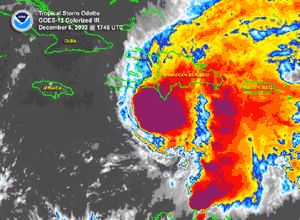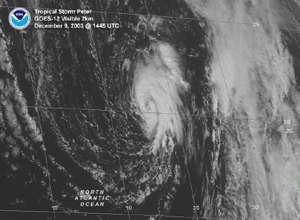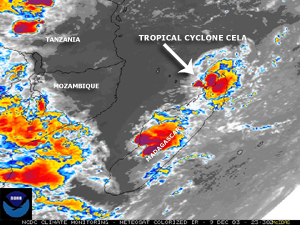
| Severe to extreme
drought was widespread throughout much of the western United
States. The most concentrated areas of extreme to exceptional
drought classification were across the Northern Rockies and parts
of New Mexico. |

larger
image
|
Hot temperatures were observed across Western Australia during
early December. Temperatures on the 2nd were 42°C (108°F)
at Port Hedland and 44°C (112°F) at Marble Bar. Normal high
temperatures in this part of Australia in early December are near
36°F (97°F).
 larger
image
larger
image
|
Wind gusts of 80 km/hr
(50 mph) caused dust plumes in New Mexico, Texas and northern
Mexico on the 15th. No fatalities occurred and the National Weather
Service issued warnings for driving hazards near Lubbock, TX due to
poor visibility and high winds. |

 larger
image
larger
image
|
Heavy rains in
Macedonia on the evening of November 30 weakened a dam that burst
on December 1, flooding parts of the town of Gradsko Baldovci.
Floodwaters displaced 750 people who were evacuated to emergency
shelters (IFRC). |
In Venezuela, heavy rains during the 3rd-5th prompted flooding
along the Limon River in the northwestern state of Zulia. The
flooding displaced at least 4,000 people.
| In the Malaysian
states of Kelantan and Pahang, heavy rains caused flooding that was
blamed for at least 2 deaths and the evacuation of 2,000 people
(AFP). The months of December through February are characterized as
a rainy season in this region with the presence of the Northeast
Monsoon. |

larger
image
|
 larger
image
larger
image
|
Heavy rains during
December 17-23 resulted in flooding and landslides across the
central and southern Philippines. At least 200 people were killed
from flooding and landslides, while a ferry sank in rough seas that
carried 75 passengers and crew. As of the 24th, only 25 people had
been recovered (AFP). |
In Bolivia, rising flood waters in the center of the county on
the 22nd claimed 6 lives and widespread material damage to houses
and roads. The government of Bolivia declared a state of emergency
as the Chapare River rose above flood stage (AFP).
Heavy rains on Christmas Day affected areas of southern
California that were just recently ravaged by wildfires in October.
The downpour produced flash flooding that resulted in mudslides,
taking the lives of 15 people at area campgrounds in San Bernardino
(AFP).
For an archive of flood events worldwide, see the
Dartmouth Flood Observatory.

In Australia, severe thunderstorms affected Melbourne on the
2nd, dumping heavy rains and large hail on the city. The storm
dumped more than 100mm (~4 inches) of rain on the city, generated
high winds and produced golfball-sized hail. Hundreds of homes and
businesses were damaged by flooding or from falling trees. Parts of
the north and eastern suburbs of Melbourne received more than 100mm
(~4 inches) in just two hours, which was described as a 100-year
storm event by the Australian Bureau of Meteorology (AFP).

 larger
image
larger
image
|
Tropical Storm
Odette
formed in the Caribbean Sea on December 4th - the first tropical
storm on record to have formed in the Caribbean Sea in December.
Odette moved northeastward while strengthening slightly to a
maximum intensity of 100 km/hr (55 knots or 65 mph), before coming
ashore over the Dominican Republic on December 6th. Odette dumped
up to 180mm (~7 inches) of rain on the Dominican Republic before
moving off to the northeast and merging with a cold front off the
coast of the United States. In the Dominican Republic, 8 deaths
were attributed to the storm (Associated Press). |
| Tropical Storm
Peter formed
on December 9th in the eastern Atlantic and initially moved
southwest and south over warmer waters. Peter then intensified
rapidly to a maximum intensity of 110 km/hr (60 knots or 70 mph or
just below hurricane strength) while moving north. However, Peter
just as rapidly deteriorated to become a tropical depression on
December 10th. The last time there have been two tropical cyclones
in the Atlantic Ocean of at least tropical storm strength during
the month of December was 1887. |
 larger
image
larger
image
|
 larger
image
larger
image
|
Tropical Cyclone
Cela
developed in the South Indian Ocean on the 5th moved across
northern Madagascar on the 9th-10th producing torrential rains and
maximum sustained winds near 85 km/hr (45 knots or 50 mph). |
| Tropical Cyclone
03B formed in
the Bay of Bengal on the 12th and made landfall in the Indian state
of Andhra Pradesh by the 15th with maximum sustained winds near 100
km/hr (55 knots or 65 mph). The storm brought heavy rains which
produced flooding that inundated 121,500 hectares (300,000 acres)
of farmland. Around 8,000 families lost their homes and 50 people
were killed (BBC News). |
 larger
image
larger
image
|
 larger
image
larger
image
|
Tropical Cyclone
Debbie
developed in the Arafura Sea on the 18th and made landfall east of
Darwin in Australia's Northern Territory on the 20th with maximum
sustained winds near 120 km/hr (65 knots or 75 mph). Debbie
produced heavy rainfall which contributed to the 3rd highest mean
December rainfall in the Northern Territory since 1890 (Australian
Bureau of Meteorology). |
 Click for Animation (~2MB)
Click for Animation (~2MB)
|
A powerful
mid-latitude storm system brought strong winds and flooding rains
to southern France during December 1-3. Torrential rains and winds
gusting up to 150 km/hr (90 mph) lashed southern France, causing 7
deaths and leaving a quarter of a million people without drinking
water (AFP). Numerous rivers went above the flood stage, with some
of the worst damage along the Rhone River. |
| Much of the
northeastern United States that had received significant snow cover during the 5th-7th had soaking
rains on the 10th-11th as a storm system trekked up the Eastern
Seaboard. Strong gusty winds and heavy rains caused accelerated
snowmelt, which produced flooding along some rivers and
streams. |
 larger
image
larger
image
|

 Nor'easter Buries The U.S. Northeast With
Snow
Nor'easter Buries The U.S. Northeast With
Snow
|
A major winter storm
impacted parts of the Mid-Atlantic and northeastern United States
during the 5th-7th. Snowfall
accumulations of one to two feet were common across areas of
Pennsylvania northward into New England. Boston, MA received 16.2
inches while Providence, RI had the greatest single snowstorm on
record with 17 inches, beating the previous record of 12 inches set
December 5-6, 1981. Boston's Logan International Airport was closed
briefly on the 7th as heavy snowfall made regular airport
operations impossible (AFP). |
| In Iran, subfreezing
low temperatures in the capital city of Tehran on the 9th resulted
in the deaths of 40 homeless people (AFP). |
 larger
image
larger
image
|
 larger
image
larger
image
|
Cold, snowy weather
across parts of the United Kingdom during December 15-23 was blamed
for as many as 2,500 deaths (BBC News). Subfreezing temperatures
and snow on the 22nd resulted in as much as 30 cm (12 inches) of
accumulation across the Yorkshire Moors. |
|
|
A storm system brought strong winds and heavy snow to Sweden on
the 6th. One person was killed by a falling tree and 90,000 homes
were left without electricity. In neighboring Norway, power cuts
were reported in the southern part of the country, where train
traffic was also disrupted (AFP).
In Germany, snow and ice caused numerous traffic accidents,
resulting in one fatality and 17 injuries (AFP). Police reported at
least 100 road accidents in the southern states of Bavaria and
Baden-Wurttemberg on the 16th.
A major snow storm in Utah occurred on the 26th causing several
fatalities due to avalanches. As much as 61cm (2 ft) of snow fell
in parts of the state, particularly south of Salt Lake City. Three
people that were seen snowboarding in the Aspen Grove recreational
area have been presumed dead, all others managed to escape or be
rescued (Reuters).
|
References:
Basist, A., N.C. Grody, T.C. Peterson and C.N. Williams, 1998:
Using the Special Sensor Microwave/Imager to Monitor Land Surface
Temperatures, Wetness, and Snow Cover. Journal of Applied
Meteorology, 37, 888-911.
Peterson, Thomas C. and Russell S. Vose, 1997: An overview of
the Global Historical Climatology Network temperature data base.
Bulletin of the American Meteorological Society,
78, 2837-2849.
|








 NOAA's National Centers for Environmental Information
NOAA's National Centers for Environmental Information

















